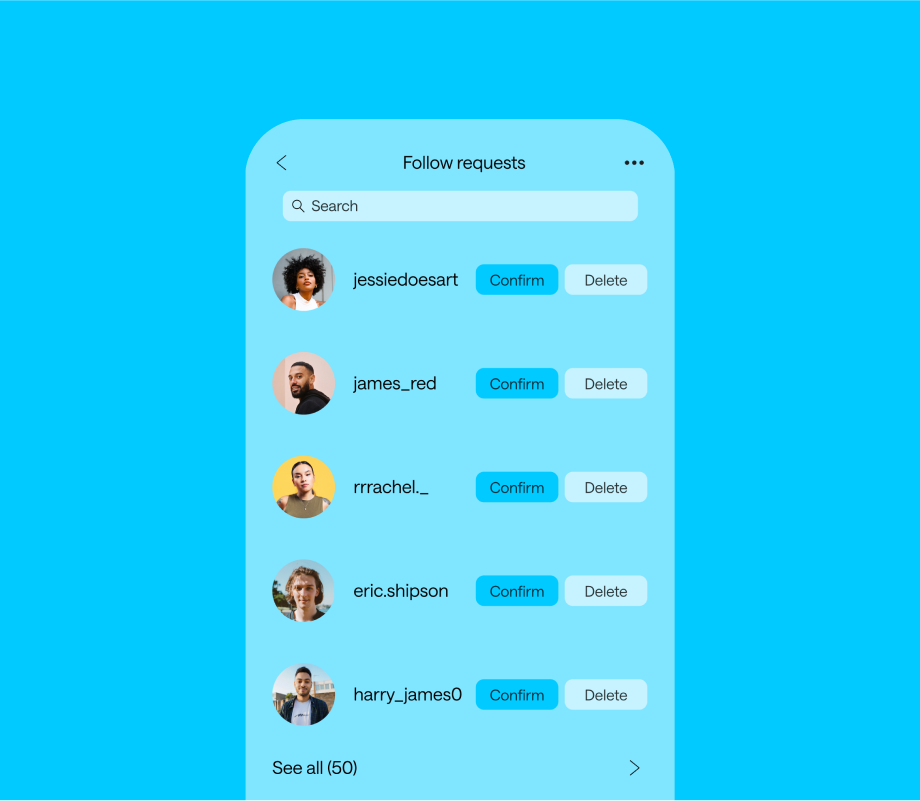Why do strategies for social media marketing fail? It's not bad luck. Studies show that poor strategy development, inadequate research, and mismanagement of stakeholders are the most common reasons strategies fail.
The facts tell us that a rare, winning idea doesn't make a strategy successful. (It's a bummer, we know.) A well-documented, intelligently built strategy is critical in 2025.
It's time to ditch the random posting and haphazard scheduling. This guide breaks down how to create a social media marketing strategy that's smart, scalable, and built for results. We'll walk you through the benefits of a well-tuned strategy and the best way to create a social media strategy that grows your brand.
Ready to stop guessing and start growing? Start a free trial with Later and see how simple strategy can be.
Table of Contents
- What is a social media strategy?
- Benefits of having a social media strategy in place
- The 10 steps in building a social media strategy
- Step 1: Audit your current social media presence
- Step 2: Know your audience better than they know themselves
- Step 3: Competitive analysis that goes beyond follower count
- Step 4: Set clear business goals (not just vanity metrics)
- Step 5: Choose the right platforms (not all of them)
- Step 6: Define your content pillars and brand voice
- Step 7: Build a high-impact content calendar
- Step 8: Distribute and repurpose like a pro
- Step 9: Measure what matters
- Step 10: Optimize continuously (test, learn, repeat)
- Perfect your 2025 strategy with Later
Join over 1 million marketers to get social news, trends, and tips right to your inbox!
Email AddressStep 2: Know your audience better than they know themselves
Guessing who your audience might be is so 2015. If you want content that actually lands, you need to know your audience inside and out. Like, you should be on their best friend level of familiarity.
First, you need to identify and define your target audience. A target audience is the specific group a brand aims to reach — people whose goals, interests, and traits align with its products or content.
You may even have multiple target audiences. For example, an orthopedic footwear company may be targeting all seniors and young to mid-adults with foot injuries.
Got your target audience in mind? Good. The next step is to define them.
Demographics (age, gender, location, income)
Interests and hobbies
Psychographics (values, lifestyle, motivations)
Online behavior and platform preferences
Pain points and needs your brand can address
Now comes the real magic: social listening tools.
Unlike simple monitoring (where you just see who tagged you), social listening tracks and analyzes everything people say about your brand, industry, competitors, and, yes, even those niche memes. Think of it as eavesdropping on the entire internet, but ethically.
Here's what social listening can do:
Spot trends before they explode
Understand how people feel about your brand (sentiment analysis)
Find out what your customers actually want (or don't)
Tune into competitor chatter and adjust your strategy accordingly
Discover low-key influencers already promoting your brand
This isn't just about staying informed. It's about gaining an edge. Social listening gives you the data to really, truly understand your target audience. You can combine your in-depth knowledge of your audience with social listening data to form a complete understanding of your target audience.
And the best part? You don't have to do it alone. Later's social listening tool makes it easy to track mentions, trends, and engagement across platforms. You're not just listening; you're leading.
FYI: Need deeper audience insights? Use Later’s analytics tools to see who’s engaging with your posts (and what they want more of).
Step 3: Competitive analysis that goes beyond follower count
It's time to stop measuring success by vanity metrics like view counts or likes alone. A social media competitive analysis is a deep dive into your competitors' activity across platforms. It helps you uncover what's working for others in your industry and how to do it even better.
Here's how to run a thoughtful, strategic analysis in four quick steps.
1. Identify your competitors
Start by listing both direct (same products or services) and indirect (related solutions) competitors. You can't outshine the competition if you don't know who they are.
2. Conduct social media research
Review their profiles on platforms like Instagram, TikTok, and Facebook. Note post frequency, content types, engagement rates, hashtags, audience interactions, and messaging style.
3. Analyze what works (and what doesn't)
Spot high-performing content, recurring themes, and possible content pillars. To take your analysis further, try conducting a SWOT analysis. This simple but powerful framework helps you evaluate your competitors from every angle. SWOT stands for Strengths, Weaknesses, Opportunities, and Threats.
Start by identifying your competitor's strengths, such as high engagement or strong brand voice. Then, note their weaknesses. Maybe their content is inconsistent or lacks a presence on a key platform.
Next, look at opportunities — gaps they haven't filled or trends they're missing that you could capitalize on.
Finally, assess threats. This is anything they're doing that could pose a challenge to your own growth, like a new product launch or an aggressive ad strategy.
4. Use a competitor analysis template
Organize your findings with a clear, shareable report. Use Later's competitor analysis template to:
Keep all your social media competitors in one streamlined, easy-to-use template.
Review competitor activity to guide smarter decisions for your own strategy.
Identify emerging trends and untapped opportunities in your industry.
Share insights with your team or manager for better alignment and visibility.
Step 4: Set clear business goals (not just vanity metrics)
The goals of your social strategy are its foundation. They inform everything the strategy does and determine how you'll judge success. All the previous research you've done shows you where your social media presence stands, what your audience wants, and how your competitors are performing.
You now know what's really possible, so it's time to set clear business goals.
Ask yourself: What does success mean for your brand in 2025? Is it more leads? Higher conversion rates? Better retention? Increased brand awareness? Your social media goals should support your broader marketing objectives, not just chase surface-level wins, like follower counts or likes.
Align goals with business objectives
The most effective social media strategies support your overall business goals, such as:
Lead generation:
Use LinkedIn or Instagram to drive qualified traffic to lead magnets or gated content.
Customer retention:
Use TikTok or YouTube to educate, entertain, and keep your brand top of mind post-purchase.
Sales growth:
Promote products with clear CTAs, track conversions, and integrate shoppable posts.
Brand awareness:
Focus on reach, impressions, and content shares to expand visibility across new audiences.
Next, you'll take your general business goals and transform them into SMART goals.
Specific: Set clear, focused goals. Instead of "get more engagement," aim for "increase Instagram post saves by 25% next quarter to boost content visibility."
Measurable: Use concrete metrics to track progress. For example, "grow Instagram Story tap-through rate from 35% to 50% within three months" is better than a vague idea of improvement.
Achievable: Keep goals realistic. Stretch yourself, but stay within reach based on your resources, skills, and timeline.
Relevant: Make sure your goals align with broader priorities or values, both personally and professionally.
Time-Bound: Set a clear deadline. A goal like "launch and track a new TikTok campaign to grow followers by 1,000 in 30 days" gives you a target and a timeline.
Step 5: Choose the right platforms (not all of them)
From past research, you already know where your target audience is spending their time. Congrats! Now, it's time to choose the right platforms to focus on.
If your audience is only on Facebook, consider pulling back your Instagram and TikTok presence and spending. If they're on a plethora of apps, you need to understand each platform's strengths, algorithm trends, and user behavior.
Start by using Pew Research to assess the usage of the major online platforms by factors including age, gender, level of formal education, and more. Next, determine shopping habits by platform. For example, a user is much less likely to follow a BeReal CTA than a Facebook CTA.
Consider your budget and scope, too. A YouTube video may cost you $5,000 to make, and an Instagram post may cost $350. Does this mean that Instagram is inherently superior? Nope! However, if your audience responds similarly on both platforms, you should prioritize Instagram.
Step 6: Define your content pillars and brand voice
Content buckets or content categories — call them what you want, but content pillars are your social media ride-or-dies. They're the go-to themes that anchor your brand's voice, keep your messaging on track, and tell your audience, "Yep, this is what we're about."
These pillars make planning your social media marketing presence much easier. For example, say you're a fine jewelry company. Your content pillars may be engagement rings, custom gold necklaces, and jewelry charms.
The good news is you've already taken the first step in pillar development. Your previously set business goals will now inform a list of potential content pillars. You'll want to settle on 3-5 content pillars, so make a healthy list of reasonable topics that further your business goals.
Pro Tip: It's time for keyword research! Content pillars should advance your SEO, so a high-traffic keyword is your golden goose.
Now, you should narrow your topics to those that touch every corner of your business and are SEO-friendly. This is also a great time to define your brand voice.
More on brand voice
Your brand voice is basically your brand's personality. It's how you talk, write, and vibe with your audience. Whether you're cracking jokes on Twitter, sending out a newsletter, or handling a customer complaint, your voice should feel like you.
It's not just what you say. It's also your phrasing, choice of emojis, and every like or repost.
Now, it's time to define your brand's tone of voice. There are three steps to get you started:
Establish your brand identity
Determine your target audience
Create a style guide
Step #1: Nail your brand identity
You can speak fluently and consistently once you've defined your brand's vibe. Ask yourself the following to form a brand identity:
What's your why?
Describe your brand in one punchy sentence.
Are you laid-back, cheeky, classy, quirky, or buttoned-up?
How would you explain your business to a friend or potential customer over coffee?
Step #2: Know who you're talking to
You may be great at puns or throwing complex jargon into a phrase, but if it doesn't resonate with your audience, it doesn't matter. Use previous audience research to inform what hits home.
Step #3: Build a style guide
This is your brand's tone cheat sheet, so everyone, from intern to CEO, stays on the same page.
Include:
Your mission and values
Your brand's "personality" in a nutshell
Dos and don'ts for grammar, language, and slang
Phrases you love and ones you'd never say
Real examples of your voice in action
Think of it as your brand's bible that keeps everything consistent, clear, and on-brand across every post, reply, and campaign.
Step 7: Build a high-impact content calendar
A social media marketing content calendar is a calendar you make to organize, plan, and schedule content across platforms. It has all the elements of every post in one place, making consistency, scheduling, and repurposing much easier.
So, how do you build a social content calendar? There's more than one way to plan your social media greatness. Here are three smart ways to get organized:
Task tools: Platforms like Notion, Asana, or Trello let you assign posts like tasks and are great for teams juggling deadlines and hashtags.
Spreadsheets: Use digital templates (Google Sheets, Excel) to build a calendar you can easily share and tweak.
Platforms: Use a social media content calendar like Later to plan, schedule, and analyze everything in one spot. It's like your own personal social media assistant.
Pro tip: Work smarter, not harder. Download our free social media calendar template to simplify your workflow and keep your strategy on point.
Once you have your calendar, it's time to implement another time-saving technique: content batching.
Content batching is a time-saving technique where you create a batch of content, like captions or visuals, all in one go. Instead of crafting one post at a time, you might spend an hour writing a week's worth of captions. It's less chaos and more efficient.
By focusing on one bulk task at a time, you make room for creativity and plan ahead with ease.
Ready to batch like a pro? These eight tips will help you streamline your social content in no time:
Lock in your content pillars (your go-to themes)
Review past posts to see what's working
Brainstorm fresh ideas your audience will love
Write a month's worth of captions in one creative session
Gather your visuals — photos, graphics, and more
Film your videos while the lighting (and energy) is right
Design scroll-stopping graphics to match your brand
Plug all of your captions and designs into your calendar when you're done.
Pro Tip: Take the guesswork out of posting. Plan your month in minutes with Later’s drag-and-drop calendar.
Step 8: Distribute and repurpose like a pro
It's time to post! You can maximize distribution through:
Timing
User Generated Content (UGC)
Collaborations
Repurposing
Repurposing content means taking something you've already posted and giving it a fresh spin for a new platform or audience. But don't just copy and paste. To make repurposed content perform, you'll need to reframe it. Think of new captions, angles, formats, or trending hooks.
For example, a meme can become a Reel, a blog post can inspire a carousel, or a TikTok can double as an Instagram Story. The goal? Work smarter, not harder, while staying creative and consistent.
When done right, repurposing not only saves time but also strengthens your brand voice and helps you reach new audiences. Here's how to stretch your content further without reinventing the wheel.
Crosspost with purpose: Take a high-performing post from one platform and rework it for another. That killer LinkedIn post? Turn it into an Instagram carousel or a tweet thread. But don't overdo it. Your audience will notice recycled content if it's a daily habit. Adapt to each platform's aesthetic and vibe.
Repurpose short-form video the right way: Your TikToks and Reels can live on both platforms. Tweak them to fit. Remove watermarks to stay on the algorithm's good side and use native fonts and audio so it feels organic on each app.
Reformat and refresh your content: It's an old post with a new twist. Turn a webinar quote into an Instagram carousel. Revive a TikTok idea for a meme. Think: one great idea, multiple formats, and a wider reach.
Step 9: Measure what matters
You've put time, effort, and creativity into your social media marketing strategy. The next-to-final step is measuring your success. This is where social media analytics comes into play, and when you collect and evaluate data from your social platforms to guide smarter business decisions.
There are two main types of metrics to track:
Descriptive metrics: What you did and what happened
Outcome metrics: The actual results and impact of your efforts
While there's no shortage of numbers to pull, the key is to focus on metrics that tell a meaningful story — one that highlights your campaign wins (woo!) and exposes what needs work.
Your social media goals don't exist in a vacuum. They live in your marketing funnel, from "just found you" to "can't live without you." The secret to properly measuring your impact is aligning your KPIs to each stage of the journey.
Top of funnel (awareness)
Goal: Get discovered and seen
Track:
Impressions and reach: How many eyeballs saw your content
Profile visits and follower growth: Are new users sticking around?
Shares and saves: Signs your content has legs
Middle of funnel (engagement and consideration)
Goal: Build interest and get people clicking
Track:
Likes, comments, shares: Indicators of brand resonance
Click-through rates (CTRs): How many users took action
Link in bio clicks: Did they visit the site?
Pro tip: Use UTM links in your bios and stories to track exactly which content led users to your site.
Bottom of funnel (conversion and loyalty)
Goal: Turn interest into action
Track:
Sign-ups, purchases, or downloads: Your true ROI
Conversion rates: Out of those who clicked, who converted?
Repeat engagement: Are followers becoming loyal customers?
Advanced move: Use multi-touch attribution to understand all user steps before converting. Don't just credit the last click. Sometimes, the meme you posted two weeks ago started it all.
Need help? Later's social media analytics tools take the guesswork out of your reporting.
Step 10: Optimize continuously (test, learn, repeat)
Standing still means falling behind. The best-performing brands don't just post and hope — they test, learn, and repeat — and now, so will you.
Run A/B tests to sharpen strategy
A/B testing lets you compare two versions of a post, campaign, or page element to see which performs better. You can test just about anything:
Captions
Post formats (video vs. image)
CTA buttons
Ad creatives
Posting times
For example, if you're unsure whether "Shop Now" or "Get Yours Today" will drive more clicks, test them on identical posts and compare the engagement. Over time, these insights compound, so you're not just creating content; you're creating smarter content.
Make every CTA count
A strong call-to-action (CTA) guides your audience toward conversions — be it signing up, shopping, or clicking a link. However, not all CTAs perform the same.
To boost your results:
Use clear, action-oriented language ("Try It Free"> "Learn More")
Make it visually prominent with bold fonts or buttons
Create urgency ("Limited Time Only," "Act Fast")
And yes, A/B test them too to see what actually drives action
Review monthly and adjust often
Social media algorithms change constantly. That's why monthly strategy reviews are essential. Evaluate your top-performing content, dig into the data, and adjust based on what's driving reach, engagement, and conversions.
Stay algorithm-aware
Regularly assess what each algorithm is prioritizing and adapt your content accordingly. For example, Instagram's algorithm ranks content based on signals like engagement, viewer behavior, and content relevance.
Optimize for success
The most successful social teams aren't afraid to experiment and never stop improving. So, test your assumptions, track your results, and tweak your strategy like the social media scientist you are.
Be a trendsetter, not a trend follower
We all work in social media because we have a knack for sensing trends and virality and somehow always identifying what works. Don't lose that special touch in the data shuffle. Keep up with the trends, and you'll continually refine your ability to predict them.
Perfect your 2025 strategy with Later
Social media isn’t just a marketing channel anymore. It’s where your audience lives, connects, and decides whom to trust. With the right strategy in place, you can turn engagement into growth and followers into loyal customers. The key? Using tools that work as hard as you do.
Later gives you everything you need to plan, schedule, analyze, and optimize your content — without the overwhelm.
Why stress when Later can help you strategize and grow? Later’s social media scheduler is the key to helpful automation and turning followers into loyal customers. Start your trial and make every post count.




